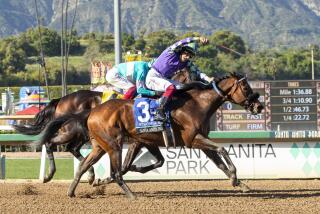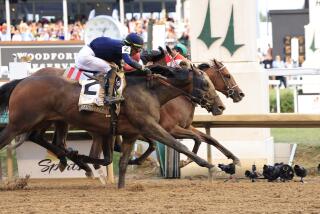The race that Barbaro could not win
The eight-month survival saga of Barbaro, a story that captured the emotions and imaginations of millions around the world and raised questions about the extent and expense of his treatment, ended early Monday morning.
Barbaro, the Kentucky Derby winner last May with a 6 1/2 -length victory margin that was the largest in 60 years, was euthanized at the hospital where he had been since the day he suffered multiple fractures in his right hind leg.
The widespread fascination with Barbaro’s ordeal was born out of the competitive nature of horse racing and an unusually long and complicated medical treatment. People who didn’t care about horse racing suddenly did.
“It was a difficult night,” said Dean Richardson, the surgeon at the New Bolton Center of the George D. Widener Hospital for Large Animals at Kennett Square, Pa. Richardson had repaired Barbaro’s three broken bones, one of which broke into 20 pieces.
“He didn’t lie down all night, for the first time since he has been here,” Richardson said at a news conference. “It was the first night that he was clearly distressed by his own condition.
“We meant what we said all along. If we couldn’t control his discomfort, we wouldn’t go on.”
Richardson said that owners Roy and Gretchen Jackson were there and were part of the decision, as they had been from the moment the horse stepped badly just 200 yards into the second leg of racing’s Triple Crown, the May 20 Preakness Stakes at Pimlico in Baltimore.
Many in racing wondered about that decision, and about the lengths to which the Jacksons and Richardson, at their behest, went to keep alive a horse who, while greatly valuable, had suffered injuries that result, in 95% of such cases, in immediate euthanasia.
“I was watching the Preakness at home,” said Rick Arthur, the equine medical director for the California Horse Racing Board who has done thousands of surgical procedures on thoroughbreds over the years.
“My first reaction was that I knew we were in big trouble. I felt right away that this was going to be a very, very long shot.”
Arthur hastened to add his admiration for what Richardson and the Jacksons tried to do.
“It’s such a sad day because this was a very near victory. People shouldn’t lose sight of that. Because of what was done here, what we learned, more horses will live longer.”
Barbaro’s injury and ensuing post-surgery battle prompted a near cult following for the horse and his story. That following became known, both affectionately and with some amazement in racing, as the Barbaro Nation.
Flowers came by the bushel, creating new wealth for the florist at Kennett Square. People wrote poems, sent apples and carrots to the hospital and, with every setback in the recovery process, went to a website that allowed electronic sympathy candles to be burned. After one recent setback, 14,000 candles were burned for Barbaro, and those came from 41 countries.
Along the way, the hospital was flooded with e-mails, prompting Richardson, a doctor with a wry wit and quick tongue, to lament the fact that he hadn’t been able to install a keyboard in Barbaro’s stall.
The Jacksons own a 190-acre ranch called Lael Farm. There, they have 70 horses. They have been involved in the racing business on different levels for more than 30 years, but Barbaro was the first horse that had ever gotten them anywhere near a Triple Crown race, much less a Kentucky Derby victory.
When the horse broke down, he did so on one of racing’s biggest stages, front row center of the Preakness. So the shock was magnified by the intensity of expectation in a sport that has struggled badly with declining attendance and increasing pressure to make its fields better and its purses larger.
Barbaro drew attention, a horse who looked as if he could get racing back on the front pages. He was huge. One of trainer Michael Matz’s exercise riders took a look at him when he arrived as a 2-year-old and assumed he was already 3.
Breeder Bill Sanborn told the Associated Press that Barbaro always stood out.
“He was an enormous foal,” Sanborn said. “He was a tall and leggy horse, and when he grew, it was like in two-inch spurts.”
Matz told reporters he had trained Barbaro for the long haul, for a run at the Triple Crown. No horse had achieved that since Affirmed in 1978, and racing has often attached increased popularity among the general populace to victories in the Derby, Preakness and Belmont by one horse.
So when Barbaro was not put down -- as less high-profile horses would have been with little fanfare -- questions arose as to motivation. Was racing trying to ease the blow for the sport by keeping its star alive? Were the Jacksons getting some push, even financial aid, in all this?
“I have never heard of a case where these expenses aren’t up to the owners,” Arthur said. “They know this is part of the game.”
Spokesmen for the National Thoroughbred Racing Assn. and Pimlico race track said Monday that their organizations did not pitch in on Barbaro’s medical expenses.
No list of medical costs has been made public. The Jacksons, in Los Angeles last Monday to receive one of racing’s prestigious Eclipse Awards, said they didn’t know what the medical bills would be. They said the bills were available from the New Bolton Center monthly, but they hadn’t gone to pick them up.
“Right now, we just don’t want to deal with the money,” Gretchen Jackson said. “If it ends up being $2 million, we’ll find a way to deal with that.”
Arthur, who has done the same procedures and is familiar with potential costs, said he hadn’t heard a figure.
“I’d doubt if it got into seven figures,” he said. “But they certainly received seven figures’ worth of expertise.”
The extent of the Jacksons’ financial wherewithal, relative to the considerable expense of running a 190-acre ranch, is not known. Roy Jackson, a roommate of former Dodgers owner Peter O’Malley at the University of Pennsylvania, was a commissioner of several baseball minor leagues and as recently as five years ago ran a sports agency that handled as many as 25 major league players. He is also a Rockefeller heir, the grandson of William D. Rockefeller, once treasurer of Standard Oil.
Gretchen Jackson, an accomplished rider who participated in fox hunts while growing up, may have been the leading advocate in the decision to keep pushing.
She is on the advisory board of the hospital where the surgery was done, and when she was home, she would make the two-mile trip to Bolton Center twice daily to visit Barbaro. Some days she brought clumps of grass from the farm because she knew Barbaro would get a scent of home as he ate.
“From the start, our only thing was to give him the best chance we could of living,” Gretchen Jackson said.
Had Barbaro lived, the Jacksons would have lost out on life insurance money due them with the horse’s death but could have made that up with expensive stud fees, had the horse been able to perform.
Artificial insemination is not allowed in thoroughbred racing, an attempt to ensure purity of bloodlines, so Barbaro’s potential family lineage died with him.
According to one source, the life insurance policy was held by Kirk Horse Insurance Inc. of Kentucky. Some estimates have put the value of the horse at $25 million, but there may be no correlation between that and the amount of life insurance taken out by the Jacksons.
A lawyer for Kirk said Monday that his company would make payout amounts public only if the recipients allowed it. He said he would inquire. No statement was made as of Monday night.
Richardson said that the only satisfaction he took from this ordeal was that the horse had eight more months, during all of which he was comfortable.
In the end, the surgeon said, the repaired fractures had held up, but injuries to Barbaro’s left hind leg, as a result of having to bear too much weight, caused him to transfer weight back to his bad right leg, and that resulted in an abscess that was the final straw. The colt also developed laminitis, a painful condition, in both his front feet.
“It was like a deck of cards,” Richardson said.
He said his only explanation for the public obsession with this story was the horse itself.
“He was loved because he was a great athlete,” Richardson said. “People love greatness. That, and the bravery he showed.”
*
Times staff writer Robyn Norwood contributed to this report.
More to Read
Go beyond the scoreboard
Get the latest on L.A.'s teams in the daily Sports Report newsletter.
You may occasionally receive promotional content from the Los Angeles Times.











